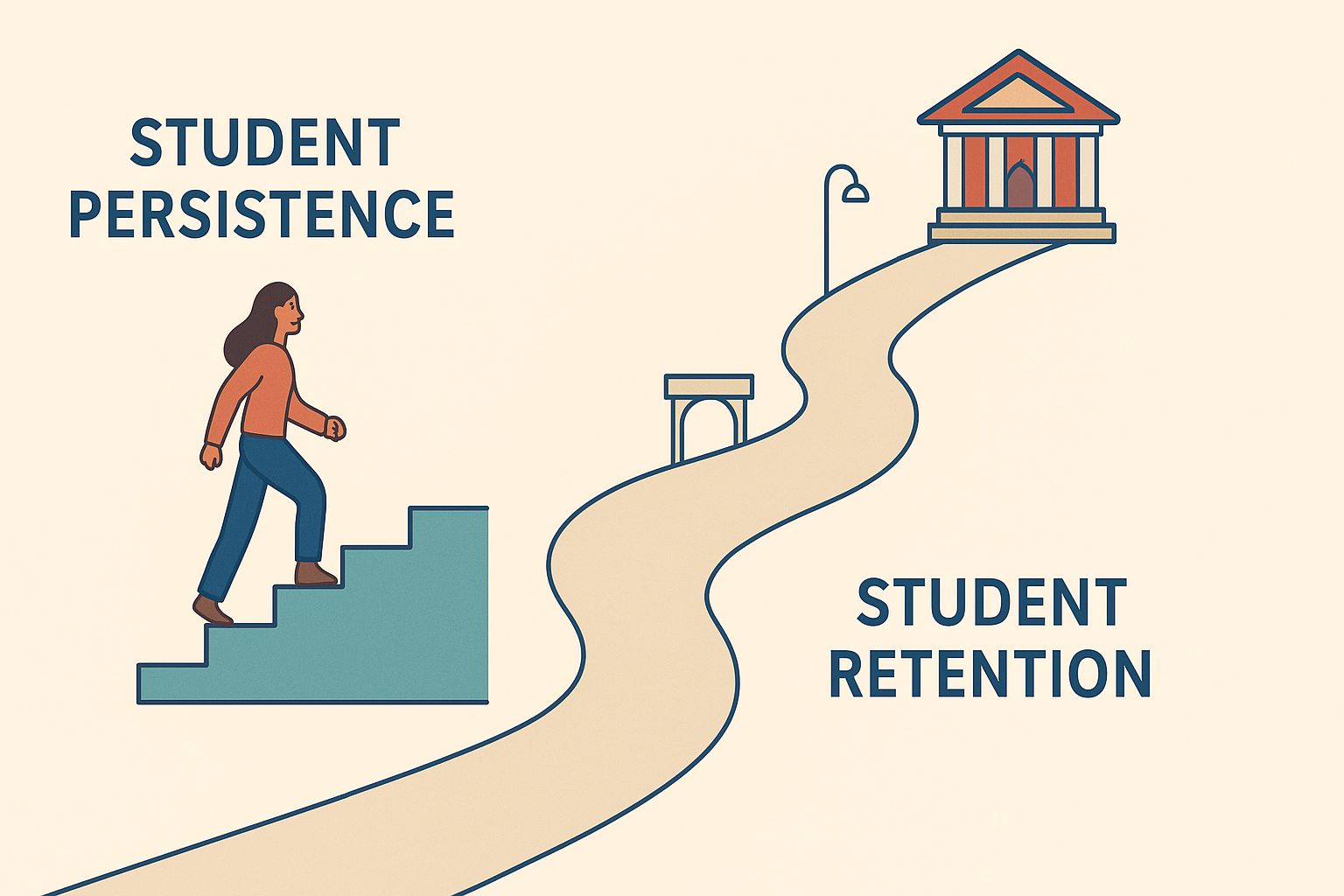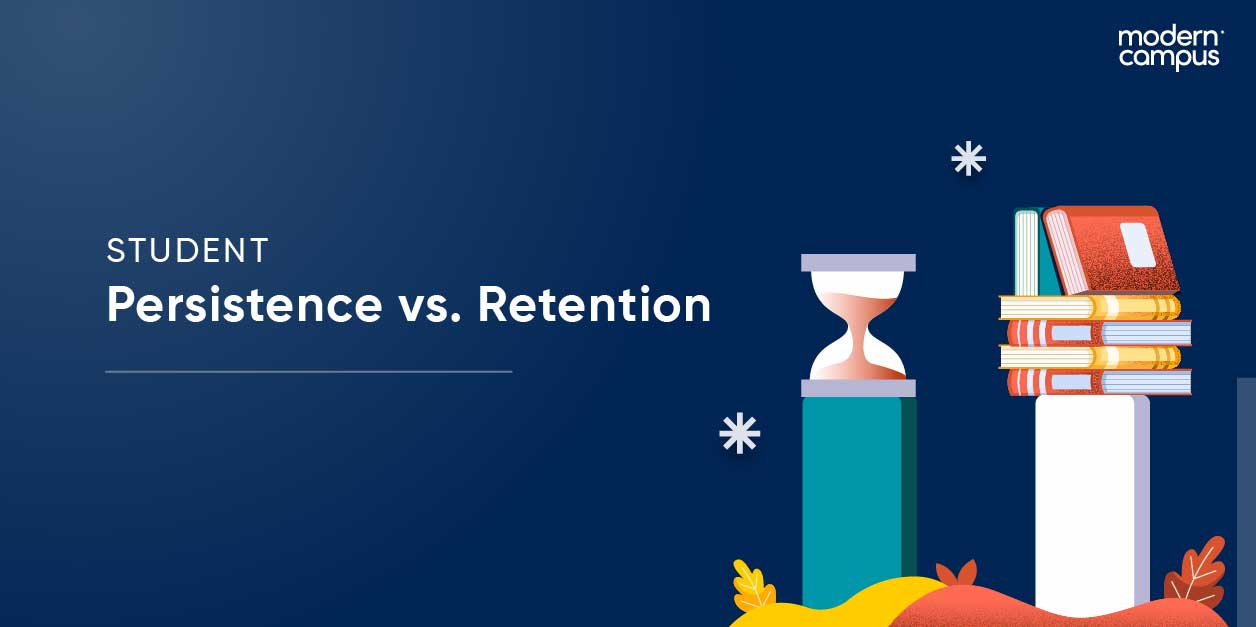Student Engagement in Higher Education: Student Retention vs. Persistence
Colleges and universities face mounting pressure to deliver outcomes that matter for institutional sustainability and the students they serve. Yet, as learner needs evolve and competition grows, success hinges on more than just enrollment numbers. It depends on keeping students engaged, supported and progressing toward their goals.
Understanding the difference between student retention and persistence is key to shaping a student journey that works. These two metrics often get used interchangeably, but they reflect distinct and equally important aspects of student success. Institutions that recognize the subtle differences can build more targeted strategies that boost both outcomes.
This article explores the nuances between student persistence and retention, offering insights and practical strategies for improving both. Fostering student engagement in higher education isn’t just a mission—it's a measurable advantage.
What Is Academic Persistence?
In higher education, academic persistence is an individual student measurement. It refers to a student staying enrolled and continuing their academic journey from term to term until they achieve their educational goals, typically earning a degree or other credential.
Persistence speaks to a student's determination, drive and use of resources to overcome challenges, adapt to new environments and push through obstacles to reach objectives.
What Is Student Retention?
Retention is a measure of institutional success. It refers to a college or university's capacity to keep students engaged and enrolled in their programs until they successfully complete their studies, typically culminating in a degree. Retention encompasses all the efforts institutions make to prevent students from leaving the college or university, whether to transfer elsewhere or stop their higher educational journey entirely.
Depending on an institution's goals, its leadership may choose to measure the retention of students in a number of different ways, such as by including or excluding part-time learners, non-traditional students or transfer students.
However, the typical “student retention rate” as defined by the majority of institutions (along with accreditors, national rankings and researchers) is first-year retention—the percentage of all first-time, first-year students who begin their enrollment in the fall term of one year and stay enrolled the following fall.
What Is the Difference Between Student Persistence and Retention?
Persistence is closely related to retention, but the terms aren't synonymous. Retention focuses on the actions and strategies employed by institutions to keep students enrolled, while persistence emphasizes the efforts and mindset of students to persevere despite expected and unexpected challenges. As explained by the National Student Clearinghouse:
“Persistence rate is measured by the percentage of students who return to college at any institution for their second year, while retention rate represents the percentage of students who return to the same institution.”
Think of retention as an institution-focused metric and persistence as a student-focused one. For example, if a student leaves their current college to enroll elsewhere, they’ve demonstrated academic persistence, but their original institution hasn’t retained them.
While distinct, student persistence and retention are closely linked. Boosting one often supports the other. When institutions invest in retention strategies, like personalized support or improved academic pathways, they naturally help more students overcome challenges and stay committed to completing their educational goals.

Persistence and Retention Rates in the United States
Recent data indicates that student persistence and retention rates have rebounded to pre-pandemic levels, marking the highest rates in a decade.
Persistence Rates:
- Overall: 76.5% of students who began college in fall 2022 continued their education into the following year, an increase from 75.7% the previous year.
Retention Rates:
- Overall: The retention rate, representing students who remain at the same institution, also saw improvements, though specific percentages were not detailed in the available data.
These positive trends suggest a recovery from previous declines, reflecting enhanced student engagement and institutional support across the higher education landscape.
Despite low rates, there are proven ways to improve persistence and retention. Check out our blog posts about it!
- Strategies for Improving Persistence in Higher Education
- Strategies for Improving Retention in Higher Education
Personalizing the Student Journey to Boost Persistence and Retention
Improving academic persistence and student retention is about delivering the right support at the right time. Modern learners expect personalized experiences that recognize their unique needs, goals and circumstances. By tailoring strategies across the student lifecycle, institutions can strengthen engagement, remove barriers and help students succeed on their own terms.
Use Data to Identify At-Risk Students Early
Not all challenges are visible on the surface. Using real-time analytics to track student engagement can reveal patterns that signal academic concerns, disengagement or external pressures. When institutions monitor key behaviors, like declining participation in online courses or missed advising sessions, they can take timely action to support students before they consider leaving. Proactive outreach is one of the most effective tools for preventing students from falling through the cracks.

Align Academic Pathways with Career Goals
Students are more likely to stay enrolled when they see a clear connection between their studies and their future. By integrating career pathway tools and labor market data into academic planning, institutions can offer personalized guidance that helps learners choose programs aligned with their aspirations. You can support student engagement in higher education while building motivation and momentum throughout the journey toward a degree or credential.
Offer Flexible Scheduling and Support
Non-traditional students, part-time learners and working adults face complex demands on their time. To support their academic persistence, institutions must provide flexibility through customizable course schedules, asynchronous online education options and self-service tools for enrollment, registration and advising. Reducing friction helps more students stay on track, even when life gets busy.
Foster a Sense of Belonging
Persistence thrives when students feel seen, supported and connected. Encouraging involvement in student organizations, campus events and peer support networks can transform a passive academic experience into an active, engaging one. Personalized communication delivered across platforms students already use can also build relationships that deepen their connection to the institution and reinforce their commitment to completing their educational goals.
Building the Infrastructure to Support Long-Term Student Success
Creating a personalized student experience demands modern infrastructure that supports every learner’s journey from start to finish. By streamlining operations and integrating the right tools, institutions can reduce friction, support student persistence and drive stronger retention outcomes. When students expect seamless access to information and services, operational efficiency and personalization go hand in hand.
Automate Routine Processes to Free Up Staff
Academic advisors, registrars and student support staff often spend too much time on repetitive tasks like course catalog updates, curriculum approvals and enrollment management. Automating these processes allows institutions to operate more efficiently, giving teams more bandwidth to focus on initiatives that truly impact student engagement in higher education. With fewer manual tasks, staff can provide timely, personalized support where it matters most.
Provide Self-Service Access to Academic Tools
College students, especially those navigating work, family and school, expect easy, on-demand access to the tools that support their academic journey. Whether they’re enrolling in courses, reviewing degree progress or exploring new programs, students benefit from digital platforms that are intuitive, accessible and responsive to their needs.
When institutions offer self-service tools, they’re reinforcing key behaviors that lead to success. By allowing students to plan ahead, manage their own schedules and make informed decisions, self-service platforms support the development of critical time management skills and strengthen self-efficacy. This sense of control and confidence is especially vital for learners juggling multiple responsibilities.
Take, for example, a part-time student balancing a full-time job and family obligations. Between external factors like shifts and childcare, she doesn’t have time to call the registrar or wait for advising appointments. But with an online learning platform that includes self-service course scheduling and program exploration, she can build a term schedule that works around her life—all from her phone, in the evenings, on her own time. Flexibility reduces stress, keeps her engaged and empowers her to persist through the inevitable challenges of higher education.

When students can manage their academic journey with confidence, institutions see stronger engagement, better retention and more meaningful progress toward degree completion.
Ensure Systems Work Together Seamlessly
Disjointed systems lead to missed messages, duplicate data and unnecessary student frustration. By integrating student information systems (SIS), learning management systems (LMS) and communication platforms, institutions can provide consistent support across every touchpoint. This seamless experience is especially critical for non-traditional students and those managing competing responsibilities. Consistency builds trust, and trust keeps students enrolled.
Measure What Matters
Improving student retention starts with understanding where and why students disengage, whether its academic challenges or financial issues. With centralized dashboards and engagement analytics, institutions can track participation trends, flag concerns early and fine-tune strategies to meet evolving needs. These insights help teams make data-driven decisions that align with real student behaviors, not assumptions, leading to better outcomes across the board.
Creating a Culture of Support That Drives Student Success
Retention and persistence are indicators of how well institutions are meeting learners' needs. By understanding the differences between the two and implementing strategies that support both, colleges and universities can create a student experience that empowers individuals to thrive academically, personally and professionally.
From using data to identify at-risk students early to aligning academic pathways with career outcomes, personalized support makes a measurable impact. When students feel seen, supported and equipped with the right tools, they’re far more likely to stay enrolled and reach their educational goals.
At Modern Campus, we help institutions like yours turn these strategies into reality. Our platform empowers you to engage learners throughout their entire journey, from the first touchpoint to graduation and beyond. Whether it’s streamlining processes, personalizing communication or integrating labor market insights into academic planning, we give you the tools to boost retention, strengthen persistence and deliver a modern student experience. Request a demo to start building lasting student relationships and drive success at scale.
Last updated: June 10, 2025



